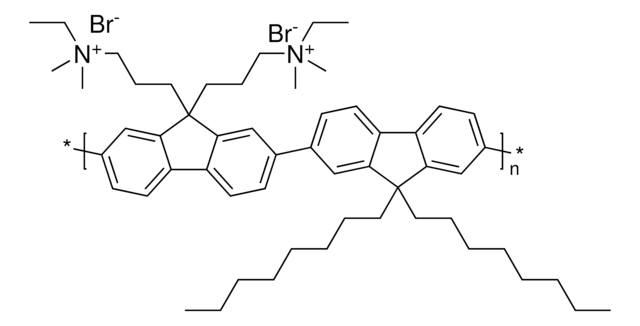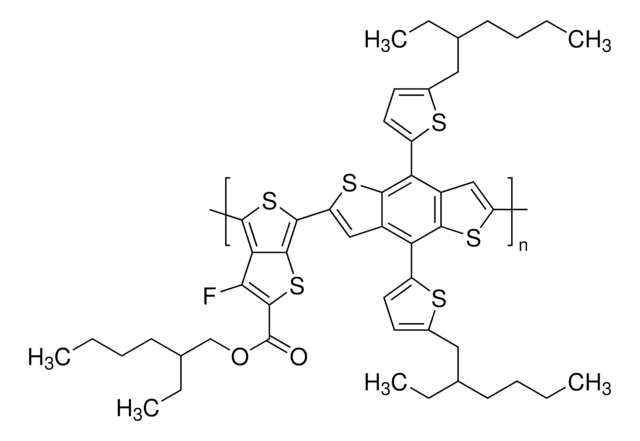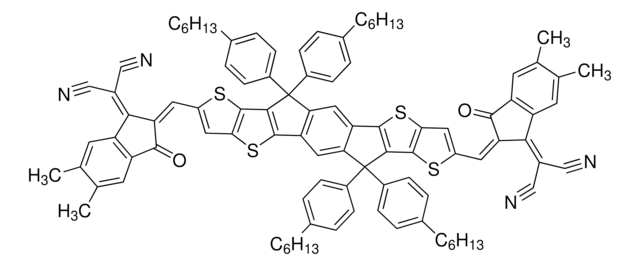Wichtige Dokumente
901423
ITIC-F
Synonym(e):
9-Bis(2-methylene-((3-(1,1-dicyanomethylene)-6,7-difluoro)-indanone))-5,5,11,11-tetrakis(4-hexylphenyl)-dithieno[2,3-d:2’,3’-d’]-s-indaceno[1,2-b:5,6-b’]dithiophene, IT-4F, ITIC-2F, ITIC-DF3
About This Item
Empfohlene Produkte
Beschreibung
Band gap: 1.52 eV
Qualitätsniveau
Assay
97%
Form
solid
Energie der Orbitale
HOMO -5.66 eV
LUMO -4.14 eV
SMILES String
Fc1cc2c(cc1F)C(=C(C#N)C#N)\C(=C\c3[s]c4c([s]c5c4C(c8c5cc9c(c8)c%10[s]c%11c([s]c(c%11)\C=C%14/C(=O)c%15c(cc(c(c%15)F)F)C/%14=C(C#N)C#N)c%10C9(c%13ccc(cc%13)CCCCCC)c%12ccc(cc%12)CCCCCC)(c7ccc(cc7)CCCCCC)c6ccc(cc6)CCCCCC)c3)\C2=O
InChI
1S/C94H78F4N4O2S4/c1-5-9-13-17-21-55-25-33-61(34-26-55)93(62-35-27-56(28-36-62)22-18-14-10-6-2)75-45-72-76(46-71(75)89-85(93)91-81(107-89)43-65(105-91)41-73-83(59(51-99)52-100)67-47-77(95)79(97)49-69(67)87(73)103)94(63-37-29-57(30-38-63)23-19-15-11-7-3,64
InChIKey
JOZQXSUYCMNTCH-ODDCUFEPSA-N
Verwandte Kategorien
Anwendung
Lagerklassenschlüssel
11 - Combustible Solids
WGK
WGK 3
Flammpunkt (°F)
Not applicable
Flammpunkt (°C)
Not applicable
Hier finden Sie alle aktuellen Versionen:
Analysenzertifikate (COA)
Die passende Version wird nicht angezeigt?
Wenn Sie eine bestimmte Version benötigen, können Sie anhand der Lot- oder Chargennummer nach einem spezifischen Zertifikat suchen.
Besitzen Sie dieses Produkt bereits?
In der Dokumentenbibliothek finden Sie die Dokumentation zu den Produkten, die Sie kürzlich erworben haben.
Kunden haben sich ebenfalls angesehen
Artikel
The emerging organic photovoltaic (OPV) technology is very promising for low-cost solar energy production. OPV devices can be produced using high-throughput, large-volume printing methods on lightweight and flexible plastic substrates, making them easy to deploy and use in innovative ways.
The emerging organic photovoltaic (OPV) technology is very promising for low-cost solar energy production.
Professor Chen (Nankai University, China) and his team explain the strategies behind their recent record-breaking organic solar cells, reaching a power conversion efficiency of 17.3%.
Global Trade Item Number
| SKU | GTIN |
|---|---|
| 901423-100MG | 4061835504312 |
Unser Team von Wissenschaftlern verfügt über Erfahrung in allen Forschungsbereichen einschließlich Life Science, Materialwissenschaften, chemischer Synthese, Chromatographie, Analytik und vielen mehr..
Setzen Sie sich mit dem technischen Dienst in Verbindung.
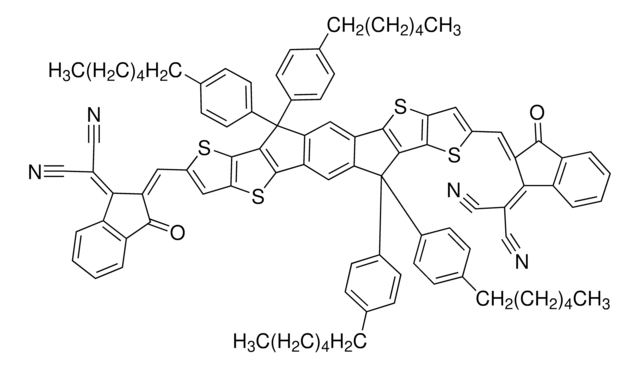

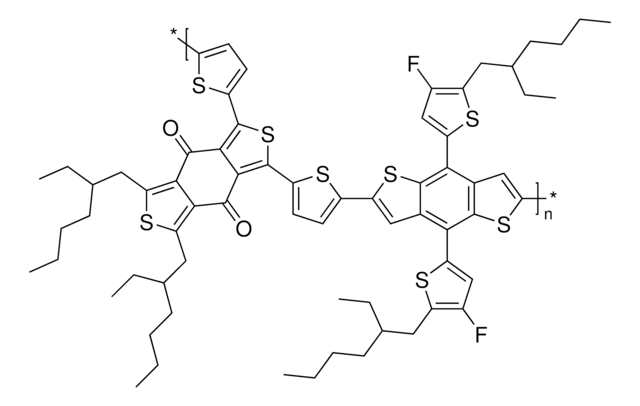
![[6,6]-Phenyl C71 Buttersäuremethylester, Isomerengemisch 99%](/deepweb/assets/sigmaaldrich/product/structures/716/624/9fb9f2f0-ae99-429f-8d3a-b12267976a4d/640/9fb9f2f0-ae99-429f-8d3a-b12267976a4d.png)
![[6,6]-Phenyl C61 Buttersäuremethylester ≥99%](/deepweb/assets/sigmaaldrich/product/structures/359/221/d990c746-0960-4c69-bf76-fe09b193824d/640/d990c746-0960-4c69-bf76-fe09b193824d.png)
